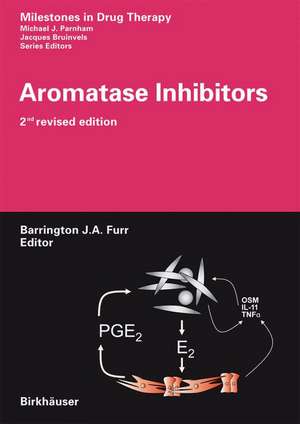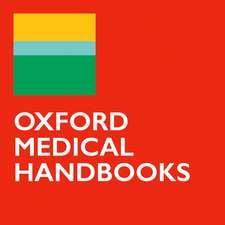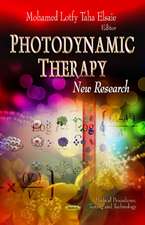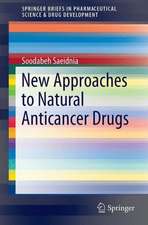Aromatase Inhibitors: Milestones in Drug Therapy
Editat de B.J.A. Furr Contribuţii de Angela Brodie, Aman Buzdar, J. Michael Dixon, Per Eystein Lonning, William R. Miller, Robert Paridaens, Evan R. Simpson, Alan E. Wakelingen Limba Engleză Paperback – 3 dec 2007
Whereas the first aromatase inhibitors to be used therapeutically could be shown to produce drug-induced inhibition of the enzyme and therapeutic benefits in patients with breast cancer, they were not particularly potent and lacked specificity. However, second-generation drugs were developed and most recently third-generation inhibitors have evolved which possess remarkable specificity and potency. Initial results from clinical trials suggest that these agents will become the cornerstones of future endocrine therapy.
Din seria Milestones in Drug Therapy
- 5%
 Preț: 1409.69 lei
Preț: 1409.69 lei - 5%
 Preț: 365.46 lei
Preț: 365.46 lei - 5%
 Preț: 371.83 lei
Preț: 371.83 lei - 5%
 Preț: 711.52 lei
Preț: 711.52 lei - 5%
 Preț: 721.77 lei
Preț: 721.77 lei - 5%
 Preț: 649.11 lei
Preț: 649.11 lei - 5%
 Preț: 1103.03 lei
Preț: 1103.03 lei - 5%
 Preț: 1407.30 lei
Preț: 1407.30 lei - 5%
 Preț: 667.36 lei
Preț: 667.36 lei - 5%
 Preț: 364.53 lei
Preț: 364.53 lei - 5%
 Preț: 1093.52 lei
Preț: 1093.52 lei - 5%
 Preț: 361.06 lei
Preț: 361.06 lei - 5%
 Preț: 708.58 lei
Preț: 708.58 lei - 5%
 Preț: 365.10 lei
Preț: 365.10 lei - 5%
 Preț: 1099.35 lei
Preț: 1099.35 lei - 5%
 Preț: 1097.18 lei
Preț: 1097.18 lei - 5%
 Preț: 1284.08 lei
Preț: 1284.08 lei - 5%
 Preț: 641.46 lei
Preț: 641.46 lei - 5%
 Preț: 1100.64 lei
Preț: 1100.64 lei - 5%
 Preț: 1606.80 lei
Preț: 1606.80 lei - 5%
 Preț: 1425.76 lei
Preț: 1425.76 lei - 5%
 Preț: 710.23 lei
Preț: 710.23 lei - 5%
 Preț: 1801.57 lei
Preț: 1801.57 lei - 5%
 Preț: 1100.30 lei
Preț: 1100.30 lei - 5%
 Preț: 1416.66 lei
Preț: 1416.66 lei - 5%
 Preț: 1092.58 lei
Preț: 1092.58 lei - 5%
 Preț: 716.65 lei
Preț: 716.65 lei - 5%
 Preț: 718.82 lei
Preț: 718.82 lei - 5%
 Preț: 715.35 lei
Preț: 715.35 lei - 5%
 Preț: 1084.72 lei
Preț: 1084.72 lei - 5%
 Preț: 1092.22 lei
Preț: 1092.22 lei - 5%
 Preț: 1092.99 lei
Preț: 1092.99 lei - 5%
 Preț: 1103.39 lei
Preț: 1103.39 lei - 5%
 Preț: 1100.85 lei
Preț: 1100.85 lei - 5%
 Preț: 1285.88 lei
Preț: 1285.88 lei
Preț: 671.70 lei
Preț vechi: 707.05 lei
-5% Nou
Puncte Express: 1008
Preț estimativ în valută:
128.55€ • 133.71$ • 106.12£
128.55€ • 133.71$ • 106.12£
Carte tipărită la comandă
Livrare economică 10-16 aprilie
Preluare comenzi: 021 569.72.76
Specificații
ISBN-13: 9783764386924
ISBN-10: 3764386924
Pagini: 200
Ilustrații: X, 189 p.
Dimensiuni: 170 x 240 x 14 mm
Greutate: 0.5 kg
Ediția:2nd, rev. ed. 2008
Editura: Birkhäuser Basel
Colecția Birkhäuser
Seria Milestones in Drug Therapy
Locul publicării:Basel, Switzerland
ISBN-10: 3764386924
Pagini: 200
Ilustrații: X, 189 p.
Dimensiuni: 170 x 240 x 14 mm
Greutate: 0.5 kg
Ediția:2nd, rev. ed. 2008
Editura: Birkhäuser Basel
Colecția Birkhäuser
Seria Milestones in Drug Therapy
Locul publicării:Basel, Switzerland
Public țintă
ResearchCuprins
Background and development of aromatase inhibitors.- Aromatase inhibitors and models for breast cancer.- Clinical pharmacology of aromatase inhibitors.- Clinical studies with exemestane.- Clinical studies with letrozole.- Clinical studies with anastrozole.- The third-generation aromatase inhibitors: a clinical overview.- Lessons from the ArKO mouse.- Possible additional therapeutic uses of aromatase inhibitors.
Textul de pe ultima copertă
Many breast tumours are dependent upon oestrogen for their development and continued growth. Over the last 25 years hormone therapy has progressed from the irreversible destruction of endocrine glands to the use of drugs that reversibly suppress oestrogen synthesis or action. The inhibition of oestrogen synthesis is most readily achieved by inhibiting the final step in the pathway of oestrogen biosynthesis, the reaction which transforms androgens into oestrogens by creating an aromatic ring in the steroid molecule (hence the enzyme's trivial name, aromatase).
Whereas the first aromatase inhibitors to be used therapeutically could be shown to produce drug-induced inhibition of the enzyme and therapeutic benefits in patients with breast cancer, they were not particularly potent and lacked specificity. However, second-generation drugs were developed and most recently third-generation inhibitors have evolved which possess remarkable specificity and potency. Initial results from clinical trials suggest that these agents will become the cornerstones of future endocrine therapy.
Whereas the first aromatase inhibitors to be used therapeutically could be shown to produce drug-induced inhibition of the enzyme and therapeutic benefits in patients with breast cancer, they were not particularly potent and lacked specificity. However, second-generation drugs were developed and most recently third-generation inhibitors have evolved which possess remarkable specificity and potency. Initial results from clinical trials suggest that these agents will become the cornerstones of future endocrine therapy.
Caracteristici
First comprehensive overview on the different aromatase inhibitors Includes preclinical and clinical studies Gives outlook on future uses of aromatase inhibitors International authorship













